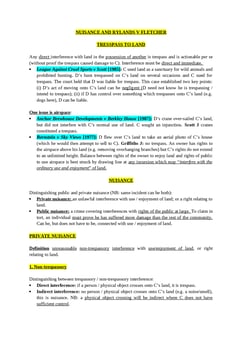Keown v Coventry Healthcare NHS Trust [2006] EWCA Civ 39
Judgement for the case Keown v Coventry Healthcare NHS Trust
Table Of Contents
KEY POINTS
It would be unreasonable to expect a National Health Service (NHS) Trust to provide protection against certain risks, such as falling from a fire escape in the context of this case.
The plaintiff was aware of the risk associated with his actions (i.e., climbing the fire escape). Thus, he did not fulfil the criteria set forth in section 1 of the Occupier’s Liability Act 1984, which requires the presence of a potential injury risk or danger resulting from the condition of the premises.
FACTS
River House, owned and used by Coventry Healthcare NHS Trust, was previously nurses' housing but had become student accommodations and a day clinic as part of Gulson Hospital in Coventry. The property had trees and two fire escapes, one with cross-bars, which went up to the third floor.
The Trust was aware that the grounds were frequented by children, who found the climbable fire escape attractive. Despite not having concrete knowledge of children climbing the underside of the fire escape, it was a known activity.
Martyn Keown fell from around 30 feet, and suffered severe injuries including brain trauma. In a subsequent legal case in May 2005, Keown testified that he understood the danger of the activity and knew he shouldn't have attempted it.
JUDGEMENT
The court ruled in favour of Coventry NHS Trust.
COMMENTARY
This case indicates the court's inclination to avoid imposing a broad and overly burdensome duty of care on premises owners or occupiers. It underscores the importance of a balanced approach to premises liability, recognizing that the mere presence of activities with inherent risks should not necessarily translate into an obligation for the premises owner to mitigate every possible danger related to those activities.
ORIGINAL ANALYSIS
Defendant knew that children used to play in the vicinity of its fire escape and Plaintiff, a child, did so. Plaintiff fell and was injured.
CA denied Plaintiff’s claim on the grounds that liability under the 1984 act related to a danger created by the state of the premises or acts or omissions done to it and NOT inherently risky activities, such as playing on a fire escape.
Premises could be dangerous for children even if they were not so for adults, but here Plaintiff knew that it was dangerous to play on the fire escape due to the risk of falling off and knew that he wasn’t supposed to play there.
CA accepted that if the injury had in fact been due to the danger caused by the state of the premises, i.e. that they were unguarded, then Plaintiff could claim.
Longemore LJ
He agreed with Lord Hoffmann (above) that an inherently risky activity did not lead to a duty of care being imposed. Otherwise, a person who climbs a mountain and trips could sue the land owner.
Any premises could be said to be dangerous if inherently risky activities are attributed to the fact that they could be performed on the premises, which would be absurd.
For Further Study on Keown v Coventry Healthcare NHS Trust
Need instant answers? Our AI exam tutor is here to help.
Ask questions 🙋 Get answers 📔 It's simple 👁️👄👁️
Our AI is educated by the highest scoring students across all subjects and schools. Join hundreds of your peers today.
Get StartedSimilar Cases
Related Product Samples
These product samples contain the same concepts we cover in this case.

 Since 2010, Oxbridge Notes has been a trusted education marketplace, supplying high-quality materials from top achievers at universities like Oxford, Cambridge, LSE, Harvard, and Yale.
Since 2010, Oxbridge Notes has been a trusted education marketplace, supplying high-quality materials from top achievers at universities like Oxford, Cambridge, LSE, Harvard, and Yale.